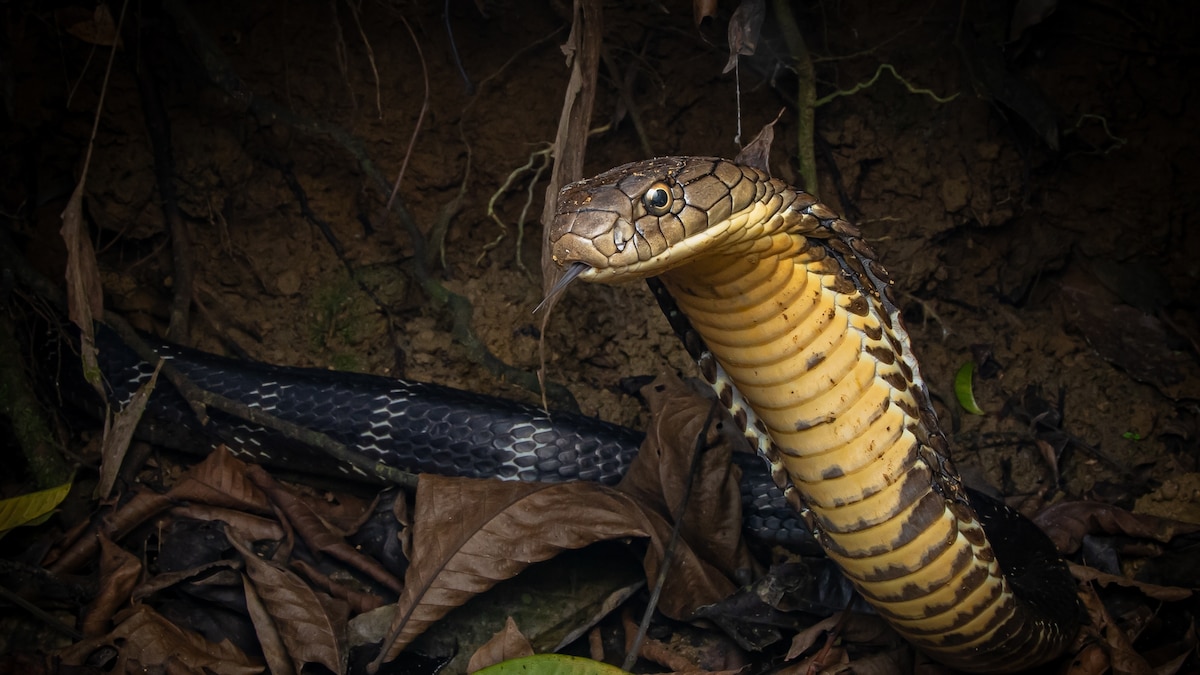Now Reading: These are the rules of king cobra fight club
-
01
These are the rules of king cobra fight club
These are the rules of king cobra fight club

The braided motions of two cobra males twisting around each other is so hypnotic that if you didn’t know better, you might think it was an intimate mating ritual—and in a way it is.
The 12-foot-long males will wrap around each other for up to half an hour in a highly ritualized struggle to push their opponent’s face into the dirt with an ignominious thud. Presumably, the snakes spar over access to females. The crazy thing isn’t so much that they fight, but that these well-known snake eaters and occasional cannibals loaded with toxic venom don’t choose the most violent path to victory. Instead, the serpents engage in a highly ritualized contest whose rules are implicitly understood by the combatants.
“King cobras are venomous—they could easily bite each other and kill each other if they wanted,” says Max Jones, a research scientist in wildlife conservation at Viginia Tech.
Video clips of ritual combat in male cobras and other snakes sometimes pop up on YouTube or other social media platforms. But researchers only made passing mention of the behavior until Jones and his colleagues described the details of three such bouts between northern king cobras in Thailand recently in the journal Ecology and Evolution.
Tracking king cobras in the wild
King cobras have gone through something of a reckoning—what was previously thought to be a single species has recently been split into four distinct species. As a result, researchers are trying to determine any differences in the ecology and behavior of the various species. (Read more about the king cobra rebranding.)
As a student at Suranaree University of Technology, Jones began studying what has since been classified as the northern king cobra (Ophiophagus hannah) while working for a project in Sakaerat Biosphere Reserve in northern Thailand in 2016. The project followed the snakes via surgically inserted radiotelemetry tracking devices to learn more about their natural history.
In 2019, Jones witnessed one ritual combat event while doing fieldwork in the reserve. “It was a spectacular event,” he says.
Later that same year, Jones acquired video footage of another fight taken at a campsite in Kaeng Krachan National Park southwest of Bangkok. And in a third case, the team found evidence of a fight by following the trajectory of tracking device data of cobras; one male had displaced another in the Sakaerat reserve, and subsequent conversations with a farmer suggested a snake fight likely occurred.
“[Combat behavior] is difficult to observe in nature,” says Alexandre Missassi , a zoologist with Museu Paraense Emílio Goeldi in Belém in northeastern Brazil who has studied ritual male combat between snakes but was not involved in Jones’ recent study. Missassi praised the new observations as a great addition to our knowledge about the natural history of cobras.
The rules of ritual cobra combat
While Jones and his colleagues only documented a small number of fights, their work hints at some basics of ritual cobra combat. All three fights occurred during breeding season—which is consistent with ritual fighting being linked to mating. Though no females were seen, researchers suspect they were close by.
You May Also Like
The bouts appeared something like a wrestling match, with each male attempting to get its chin onto the back of its opponent’s head and force its face down to the ground. This happens again and again, seemingly going back and forth without a clear victor until one of the snakes—usually the smallest—slithers off. In all three episodes, neither snake bit its opponent.
In the two direct observations, the snakes didn’t even so much as open their hoods. Jones says this is likely because such a display is unnecessary—the hoods are usually a way to scare off creatures not otherwise aware of the dangerous venom they carry. But a cobra knows a cobra. “In these situations, they have no gain to [open their hoods]—they’re not going to fool each other, they aren’t going to scare the other one away,” he says.
Size matters among sparring king cobras
In all of these cases, the snakes were big—the smallest was 11.5 feet long while the largest was more than 13 feet. The snakes coiled their long bodies around each other a little like Twizzlers licorice, with their heads rising above the ground. “It’s just a mass of snake,” Jones says.
Respect for the opponent’s size may be what keeps them from biting. Cobras—just like others in the elapid family like coral snakes—are well-known serpent eaters, preying on smaller species. They are also prone to cannibalism—males will even eat smaller females outside of the mating season.
As a result, when it’s not a ritual fight over mating rights, combat has higher stakes when the weight class is skewed, says Vinícius Mendes, a snake expert at the TaxaMundi institute in Brazil, who has studied coral snake fights but was not involved in the cobra study. If there were a bigger difference in size, we would see more bites, he says.
But these ritual fights may have ended without bloodshed because the snakes were fairly evenly matched—another large male cobra would be too much to swallow, literally.
Conserving cobra habitat
In one of the three cases reported by Jones’ team, the match went at least half an hour. The victor likely earned the right to attempt mating with a nearby female hidden from the researchers’ view. But she might not expect much from him right away—the snake is probably wiped out from marathon fight.
“This is an extremely intensive, and I imagine extremely tiring event for two large snakes to have to put up with,” Jones says.
Jones says this struggle highlights the importance of conserving mating habitat for cobras, who may be more vulnerable to humans as they recover from epic contests for the favor of a nearby female. People are often afraid of king cobras, though they rarely bite and typically try to threaten first. But fights in open areas make them vulnerable to humans, who may take their ritual distraction as an opportunity to come in and lop their heads off with a machete, Jones says.
Learning more about the kinds of habitats that cobras use in these fights, and for reproduction in general, could help with conservation, notes Mendes. With more protected land, snakes that lose the fights may be more likely to explore and—if their luck and strength is with them—find another female to mate with.

























